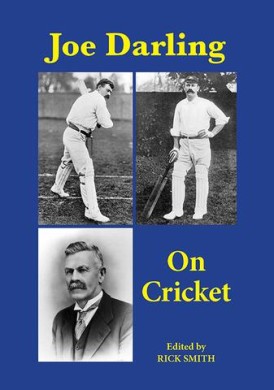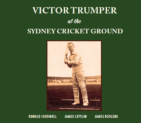Joe Darling on Cricket
Martin Chandler |Published: 2018
Pages: 219
Author: Smith, Rick
Publisher: Apple Books
Rating: 3.5 stars

Joe Darling played in 34 Tests between 1894 and 1905, and led Australia in 21 of them. He was a left handed batsman whose playing record, other than one stellar series in 1897/98 when he scored all three of his Test centuries and averaged 67.12, is relatively modest. Nonetheless he was a popular and successful captain and if his overall record is a little disappointing, he has always been regarded as an example of the sort of batsmanship that gave the so called ‘Golden Age’ its reputation.
Many less interesting cricketers than Darling have been the subject of books in the past and it is surprising therefore that up until now there has only been one slim memoir of Darling, privately published by one of his sons in 1970. In 2018 however not only do we have this book, but a full biography of Darling is due from the pen of Bernard Whimpress in the near future.
For now however we have Joe Darling on Cricket to whet our appetites. The book, inevitably and quite properly, carries an introduction summarising Darling’s career and his life before setting out its main purpose, that being to gather together Darling’s writings on the game.
An interesting character it is worth stressing that Darling had no training as a journalist, nor any commercial need to write. By the time his work started appearing he had long retired from the field of play and was living in Tasmania where he owned land and, later, enjoyed a career in politics. Those endeavours aside he also found the time, between 1924 and 1933, to produce a series of articles for a couple of Tasmanian newspapers. After the first folded he joined the second, and after that too ceased publication he seems to have stopped writing altogether.
There is nothing that Darling wrote about that has not been written about by others, but his views, measured yet firmly expressed, are certainly interesting. As Rick Smith observes the style of Darling’s writing can be a little convoluted, and is very much of its time, but at the same time it remains eminently readable.
During the period over which Darling was writing Australia toured England in 1926 and 1930. On neither occasion did Darling travel to England and therefore his pieces on those tours are not match reports as such, and some of his views inevitably rely on the observations of others. A feature of all Darling’s writing, but particularly in relation to matches he does not himself see, is that it is laced with the benefit of his own past playing experiences.
Even in the home series of 1924/25, 1928/29 and 1932/33 Darling was not present at all the Tests, but he did see some of the play. He saw two Tests in the first of those series, one in the second and two in the third. In particular he was present at the third Test in Adelaide in 1932/33, the flashpoint of that series.
Perhaps inevitably therefore the most interesting chapter in Joe Darling on Cricket is the last, that which covers the great Bodyline controversy. No doubt a limited circulation around Tasmania is what has stopped Darling’s work being better known and for aficionados of Bodyline, of whom there are a considerable number, the existence of a previously unseen body of work on the series will, I suspect, cause some excitement and they will make up a considerable proportion of those who choose to invest in Joe Darling on Cricket.
There is nothing unusual in Darling’s views, but they are strongly expressed without the element of hysteria that crept into the writing of some of his countrymen at the time. In response to the assertion that nothing in the laws of the game forbade Bodyline Darling’s response, whilst acknowledging that to be correct, was to make the observation that neither was there anything in those laws to prevent the batsman striking the bowler with his bat, but that that didn’t make such actions acceptable. Despite that observation however Darling did take the same line as Australian skipper Bill Woodfull, that retaliation was not the way forward.
What is most interesting, and Bodyline is not the only subject where this proves to be the case, was how prescient some of Darling’s observations were. He clearly foresaw what would happen when Bodyline bowling was unleashed in England during the summer of 1933, and that Test cricket had seen the last of Douglas Jardine and Harold Larwood. It is perhaps a shame that by the time the 1934 Australians were playing in England Darling’s writing career was over as his opinions on the aftermath of Bodyline would have been just as interesting if not more so than the views he was expressing as the drama unfolded.
Its subject’s writing career over Darling on Cricket concludes with a brief look at the statistics of Darling’s playing career and it has an excellent index. It is a well illustrated and pleasingly designed paperback available in a signed and numbered limited edition of 101 copies which, not being a large limitation, suggests that early purchasing might be prudent.






Leave a comment